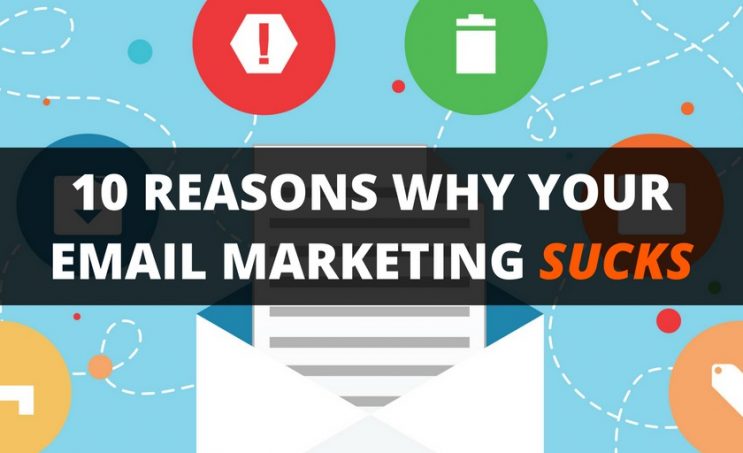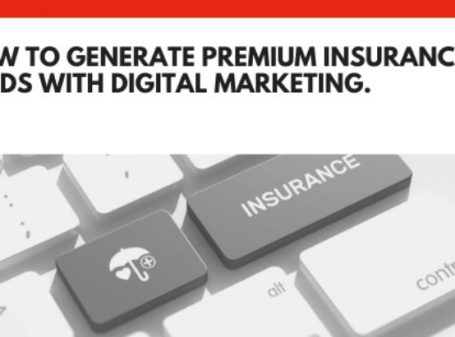10 Reasons Why Your Email Marketing Sucks
By: Rank Media

Eons ago (hyperbolic effect intended), receiving a new email used to be a joyous and wonderful occasion. In fact, the growth of email was fun to watch, especially as Hollywood capitalized on the emerging trend by developing a whole film around the “You’ve Got Mail” tagline with Tom Hanks and Meg Ryan.

Of course, that feels like eons ago. Nowadays, inboxes are full of messages, ranging from bills and personal messages to work requests and spam…lots and lots of spam. Not only do we suffer from email overload, but it’s not unusual for people to have multiple email accounts. Some stats from The Radicati Group reinforce the notion that we have become email crazy:
- Over 2.5 billion people actively use email, with that number likely to reach 3 billion by 2019.
- Over 205 billion emails were sent per day in 2015, with the number likely to reach 246 billion by 2019.
- The average number of business emails sent and received is 123, which is why people suffer from email madness when coming back from vacations.
- The average amount of spam received on a daily basis continues to increase, which can be as much as 13% according to the study.
This is why it’s critical to maintain visibility when it comes to email marketing. If the average person has to go through 100 emails every day, the likelihood of your newsletters and promotions getting ignored is reasonably high. One of the goals of strategic email marketing is to get people to open your emails so that you can push them along the conversion funnel. However, if you’re making some basic mistakes, performance will suffer. If your open rates are already abysmal and you’re wondering why people are simply not resonating with your messaging, you may be making one (or more) of the following mistakes.

1. You are using generic send names
Oddly enough, this seems like one aspect that a lot of businesses haven’t quite optimized yet. Often forgotten during the setup process, the send name is usually given a standard moniker such as “info@” or “noreply@,” which means absolutely nothing to your recipients when they are browsing through hundreds of emails. The “noreply” moniker especially doesn’t sound inviting at all and it baffles me every time I see this used by major brands. You should be encouraging your users to speak with your team via social or email, not asking them to stay quiet.
2. Your subject lines are too long
As referenced previously on this blog, yours truly believes that marketing for mobile devices is becoming more important every day. With 40% of emails being opened on mobile devices, it’s extremely important to get your point across in a clear and concise manner. With that in mind, if you are in the business of jamming subject lines with a bunch of content, your open rates will most likely suffer. For example, see the two subject lines below – which one do you think would generate a higher open rate?
- Subject Line 1: Learn How You Can Boost Your Rankings To Generate More Leads And Conversions With Our Handy Guide!
- Subject Line 2: Increase Rankings With This Exclusive Guide.
It may sound simplistic, but in this case, brevity converts.
3. Your segmenting is non-existent
The best part about cultivating an email marketing database is the information that you can collect from users. For example, some of the standard information you can capture regardless of your business objective include the following:
- Gender
- Language
- Address / Location
- Birth Date
- Signup Path
On top of that, you can encourage your users to provide a myriad of pertinent information depending on what kind of audience you’re targeting. For ecommerce brands, tracking purchasing frequency and types of products acquired can help you tailor promotions and new products to their taste. B2B marketing professionals can segment lists based on company names, job titles, organization size, and other salient information.
Gathering as much data as possible from your database can only translate into better results, especially if you set up automated marketing messages that are sent to specific segments (e.g., product recommendations, which is Amazon’s bread and butter). Unfortunately, despite collecting this data, some people make the mistake of sending one version of an email to an entire database and thinking that alone can get the job done. If you’re not targeting content to the right segments, people won’t bother opening the email.
Unfortunately, despite collecting a plethora of data, some businesses will make the mistake of sending one email to an entire list without curating content to specific audiences. With segmenting capabilities widely available in paid media campaigns on Google AdWords and Facebook Ads, why wouldn’t you do the same thing with regards to email marketing?
4. You are sending emails at the worst possible times
While the perfect send time for email marketing can be disputed among many businesses in the same niche, there have been a lot of studies and research into campaigns on a holistic level. Some key insights from reputable members within the email marketing industry include:
- MailChimp: After analyzing data from its send time optimization feature, the best engagement occurred around 10:00 AM.
- Dan Zarella: 6:00 AM and 8:00 PM on weekends generated the best open rates and click-through rates through Zarella’s research.
- GetResponse: An analysis of over 300 million emails in October showed that Tuesday was the best day of the week for optimal open rates.
- HubSpot: Once again, Tuesday reigns supreme in this study from HubSpot, with this particular weekday performing 20% better than other days on average.
- Customer.IO: Due the “reality of work” setting in on Tuesday, over 17% of all emails are sent on Tuesday.
- SmartInsights: While the best time to send emails depends on the recipients and content, the afternoon – more specifically, between 12:00 PM and 4:00 PM – tends to generate the best engagement rates.
As exhibited above, there seems to be a recurring theme with regards to the best send times for your email marketing programs, which is that you should only launch marketing campaigns when your audience is either active (in the middle of a work day) or awake. It’s essential to know the geographic makeup of your database so that you can send out emails according to their time zone. If there’s no need to segment your list geographically for promotions, then you can utilize special features, such as MailChimp’s Timewarp mechanism, to send emails at a specific time within each time zone (e.g.: sending emails at 10:00 AM EST, CST, MST, PST, etc.). The salient takeaway from this part of the blog post is to ensure that you’re not missing out on potential conversions by sending emails when your audience is passed out in bed.
5. Your subject lines fail to get to the point

Sometimes ambiguity can work. Other times, it can fail miserably.
If you’re nurturing leads according to a specific lead flow in your marketing campaigns, it is imperative to be direct and let your recipients know what awaits them when they open your email. For example, if your lead magnet directs users to a landing page where they can receive a coupon code or an ebook in exchange for subscribing to your newsletter, your autoresponder’s subject line should indicate that the prize for signing up is included within the email. If your subject line is either ambiguous or unrelated to the user’s path in the lead flow, then your email may be ignored and thrown away.
6. You consistently make false promises and/or use bait to increase open rates
With regards to this point, it’s more related to the performance of particular campaigns and the after-effects that reverberate within each additional email marketing campaign. If you’re landings pages or opt-in popups promise users one thing and give them another within an email, you won’t be able to elicit any trust from your database.
Additionally, if you’re in the habit of using “click-bait” worthy subject lines to inflate open rates, your recipients will become disenchanted with your brand and ignore forthcoming emails. It’s better to be completely honest with your audience and deliver exactly as promised than to utilize spammy and/or black-hat tactics to build up your database. Being truthful with your audience will also ensure that you won’t see an inflated number of complaints and spam reports in your campaign data, which will keep your list active and healthy.
7. You are not creating a sense of urgency
When it comes to pushing new offers and promotions, you need to have actionable subject lines that encourage users to take action within a limited period of time. Doing so will create excitement and galvanize users to open your email and taking action as specified in your lead flow. However, if you do not create a sense of urgency, especially for limited time promotions, then you will fail at getting your database excited and your emails will be ignored.
For example, if you’re an ecommerce brand, using a subject line such as “Get 20% Off Your Next Order – Offer Expires At Midnight!” will no doubt perform better than “New Daily Flash Sale: Save 20% On Your Next Order.” Not only are you using an actionable subject line (“get 20% off” reads better than “save 20%”), you are specifying a deadline for the promotion, which will prompt users to open the email before the offer expires.
By creating a sense of urgency or exclusivity, you’ll be sure to see higher open rates within your email marketing campaigns. In fact, by simply adopting this strategy, some businesses have seen a 22% increase in open rates.
8. You are not using numbers and emoji in your subject lines
Using numbers and emoji can help your subject lines stand out, especially if you are keeping them concise and straight to the point. Additionally, numbers provide finite data when it comes to making statements. Just look at the two examples below – which one do you think will get a better open rate?
- Subject Line 1: Get the secret the boosting your rankings today!
- Subject Line 2: Get the secret to boosting your traffic by 250% today!
As you can see with the example above, the number stands out within the second subject and will most likely generate a better open rather than the first subject line. You can also make your subject lines stand out on mobile and desktop devices by strategically using relevant emoji. While the data behind the impact of emoji still doesn’t sway one way or the other, the correct usage of emoji can help reinforce the message and increase open rates. To better gauge the performance of emoji within your campaigns, you can always setup small A/B tests and compare the results against other subject lines.
9. You are using too many exclamation points or caps

No one likes being yelled at, especially when it comes to email marketing. While you may want to create a sense of urgency as explained above, you want to refrain from using all caps for your subject line or drowning the text in exclamation points. In fact, 85% of survey respondents indicated a preference for subject lines that were all lowercase to one that’s written with the caps lock enabled.
This one seems straightforward. If you’re currently employing either of these tactics (too many punctuation marks and/or caps), you’ll want to apologize to your readers first and then cease the usage of both.
10. You are not A/B testing
This is probably the most common mistake being made by email marketing professionals. A/B testing has become a refined feature in many email marketing platforms, with some providing advanced multivariate testing where you can test combinations of subject lines, send names, and content.
Not utilizing A/B testing features when they are readily available is only setting yourself up for failure because you are relying on assumptions before executing campaigns. Even the most experienced subject matter experts will tell you that they get things wrong once in a while (for example, I once thought Google+ was cool, but that prediction turned out to be worth nothing). By making an assumption and foregoing A/B testing, you may never find the winning formula for campaigns.
What now?

If you’ve been making some of the mistakes referenced above, don’t worry: you still have a chance to turn your campaigns around and increase conversions from your email marketing efforts. While it’s virtually impossible to get every single person subscribed to your lists to open every single email, you can turn your performance around by internalizing some of the advice within this blog post and employing some of the strategic tactics laid out in each section. Also, note that the subject line is only one piece of the puzzle: you also have to optimize other elements of each email marketing message, such as the preview text, the template’s design, the content and messaging, the landing page for the campaign, etc. However, tinkering with your subject lines can provide an uptick in open rates, which is the first step to improving your digital marketing performance.







 (800) 915 7990
(800) 915 7990
